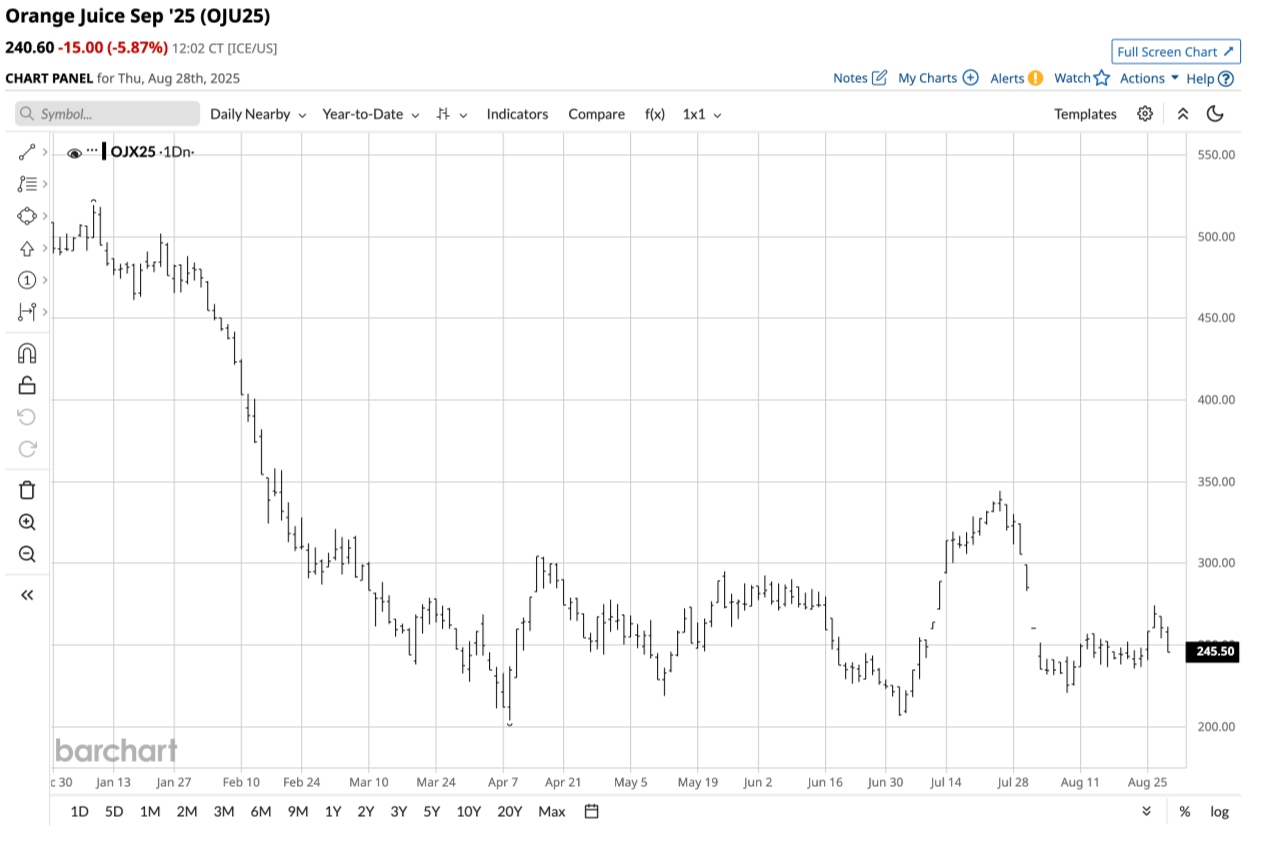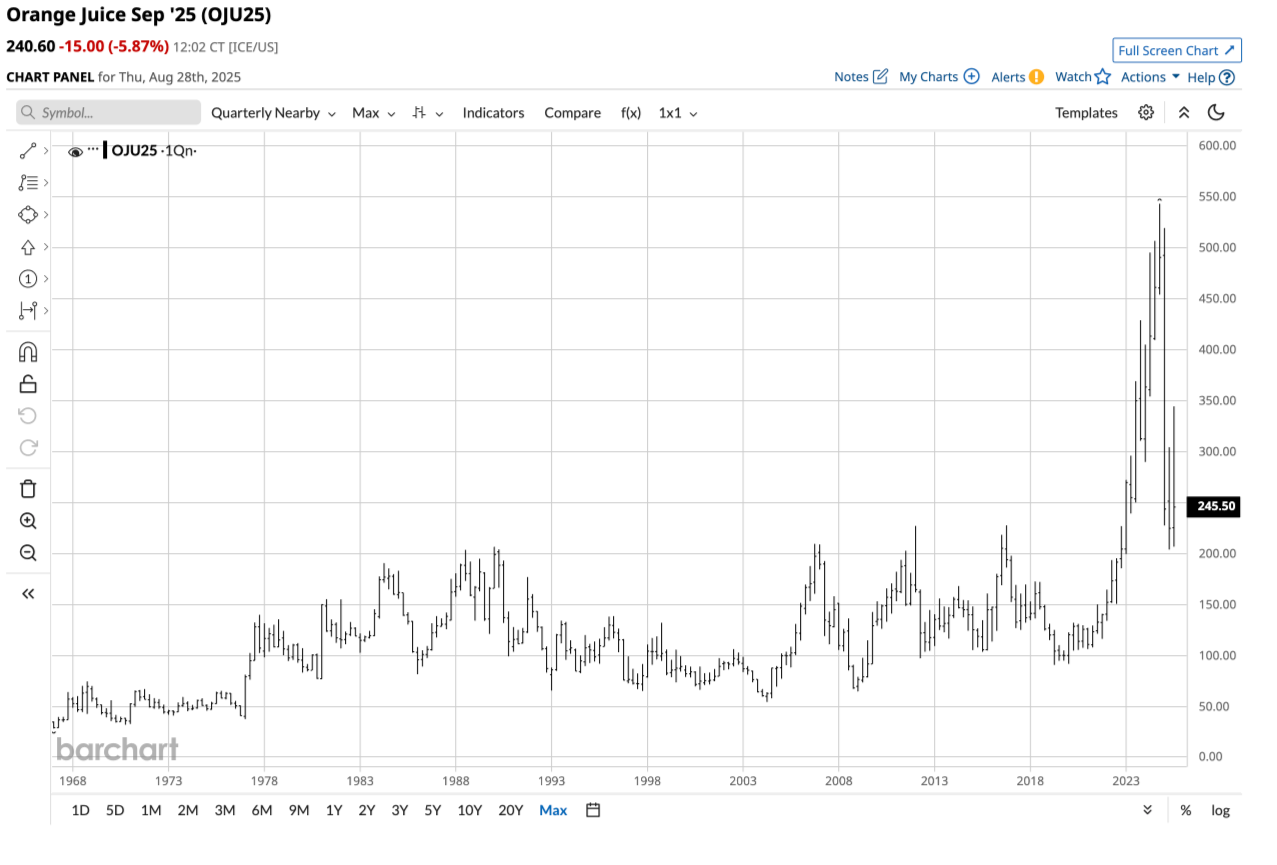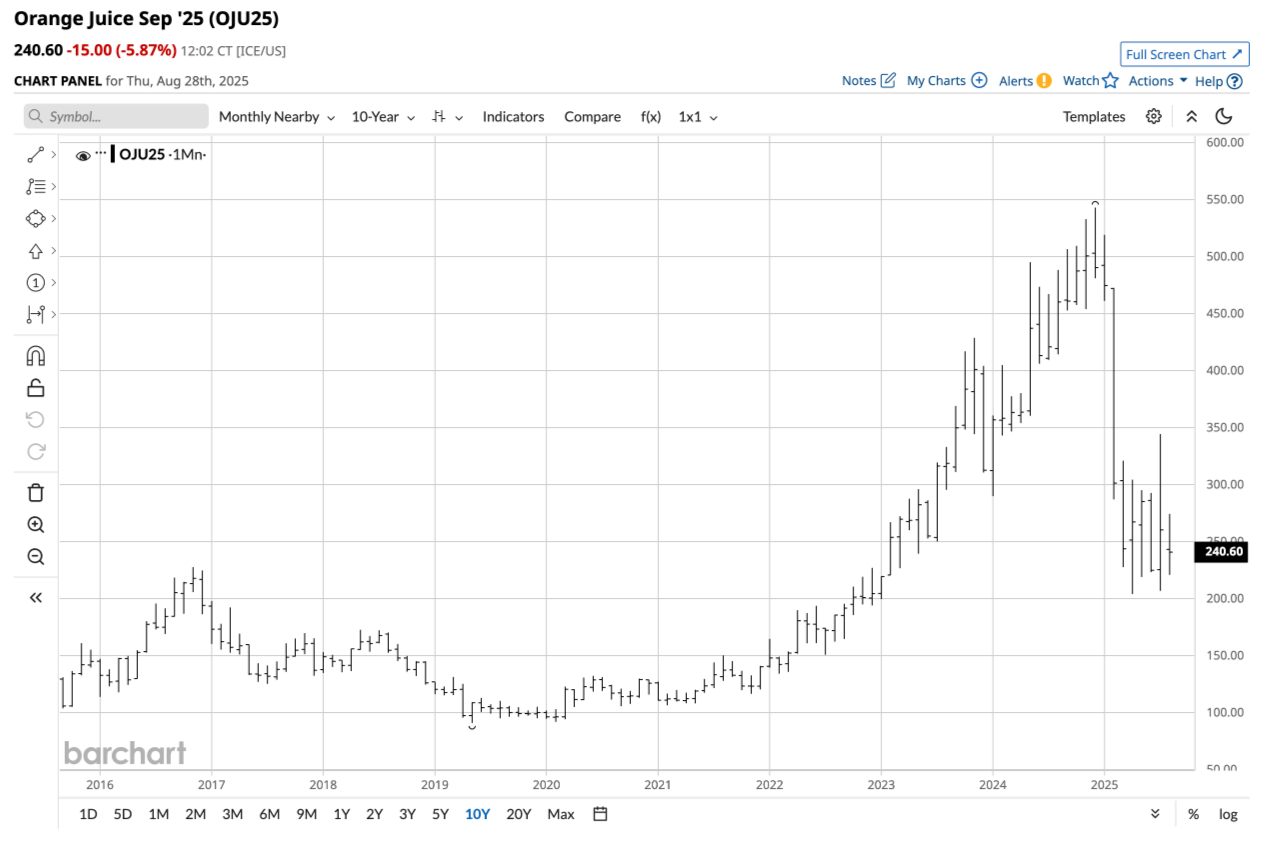|
|
|
|
|
Name
Cash Bids
Market Data
News
Ag Commentary
Weather
Resources
|
How Low Can Frozen Orange Juice Futures Fall?
In a late December 2024 Barchart article on the FCOJ futures market, I concluded with the following:
Nearby FCOJ futures on the Intercontinental Exchange were trading at $5.0475 per pound on December 27 after reaching a record high of $5.4315 a few days before. At half the price in late August 2025, FCOJ futures remain in a bearish and choppy trend since late 2024. FCOJ futures correct lowerThe ICE FCOJ futures for September delivery experienced the most significant decline in 2025 from January 8 through April 8. 
The daily chart highlights the 60.75% from $5.1930 to $2.0380 per pound. Meanwhile, the September FCOJ futures have traded in a sideways range from $2.0660 to $3.4430 since April 9, 2025. At the $2.4060 per pound level in late August, the FCOJ futures are closer to the low end of the trading range. FCOJ is higher than the Q2 closing priceFCOJ futures moved 10.63% lower in the second quarter and were 56.25% lower than the 2024 closing price on June 30, 2025, when the nearby futures contract settled at $2.1765 per pound. 
The long-term quarterly FCOJ chart since the 1960s highlights, that the soft commodity rose above the late 2016 $2.2750 per pound record high in Q1 2023 on its way to well over double the 2016 peak when it traded at $5.4315 in Q4 2024. At just over $2.40 in late August 2025, FCOJ has substantially corrected from its high in late 2024, but remains above the Q2 2025 closing price and the previous record high from 2016. Supply issues should continue to support pricesOranges are an agricultural product, so annual supplies depend on crops. Brazil is the leading orange-producing country, accounting for approximately 30% of the world’s annual orange supply. The United States is the second-largest producer, accounting for approximately 10% of global production. Crop diseases and poor weather conditions have impacted supplies. Citrus greening, a crop disease impacting oranges, has spread through Florida and Brazilian orange groves. Moreover, hurricanes, droughts, and unfavorable growing conditions have further reduced crop yields over recent years, leading to the record high in late 2024, and elevated prices in 2025. Technical support and resistance levels suggest continued price volatilityThe ten-year monthly continuous FCOJ chart highlights the technical targets with the soft commodity around the $2.40 per pound level in late August 2025. 
The chart indicates that, given the April 2025 low of $2.0380 and the July 2025 low of $2.0660, the critical technical support level is approximately $2 per pound. Technical resistance is at the July 2025 high of $3.4430. FCOJ is a highly volatile soft commodity, making for extremely wide technical support and resistance levels. The width should come as no surprise, as FCOJ futures traded on either side of the support and resistance levels in July 2025. FCOJ futures are the least liquid soft commodity- Futures are the only option for participationThe soft commodities sector includes the tropical commodities that trade on the Intercontinental Exchange, including world sugar, Arabica coffee, cocoa, cotton, and frozen concentrated orange juice futures. FCOJ is the least liquid soft commodity, considering its futures open interest and daily volume. Open interest is the total number of open long and short positions in a futures market. As of August 28, FCOJ had 7,926 contracts of open interest. At $2.4060 per pound, with each contract consisting of 15,000 pounds, the total value of the ICE FCOJ market was just over $286 million, making it a relatively small futures market. Daily volume typically falls below 2,000 contracts, with fewer than 1,000 contracts trading on many days. Low open interest and volume cause illiquidity, which tends to lead to increased volatility when trends develop. Less liquid markets tend to experience price gaps as a lack of bids to purchase or offers to sell can lead to substantial price movement without any futures contracts changing hands. These gaps increase the risk of trading in illiquid markets, such as the FCOJ market. Meanwhile, futures are the only options for market participants seeking price exposure to the FCOJ market. FCOJ is in a bearish trend in 2025, but the longer-term path of least resistance remains bullish, with the price remaining above the previous record high from late 2016. The weather and crop diseases in Brazil and the U.S. will dictate whether lower lows are on the horizon or if the coming months and 2026 will continue to be a period of elevated prices. On the date of publication, Andrew Hecht did not have (either directly or indirectly) positions in any of the securities mentioned in this article. All information and data in this article is solely for informational purposes. For more information please view the Barchart Disclosure Policy here. |
|
|